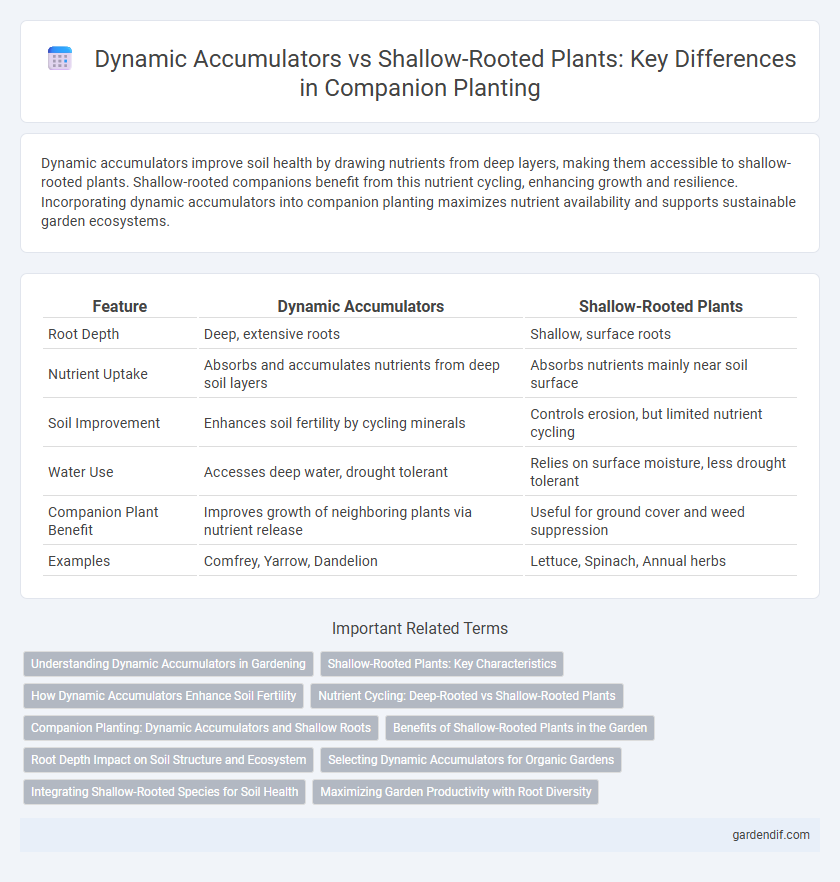
Dynamic accumulators vs shallow-rooted Illustration
Dynamic accumulators improve soil health by drawing nutrients from deep layers, making them accessible to shallow-rooted plants. Shallow-rooted companions benefit from this nutrient cycling, enhancing growth and resilience. Incorporating dynamic accumulators into companion planting maximizes nutrient availability and supports sustainable garden ecosystems.
Table of Comparison
| Feature | Dynamic Accumulators | Shallow-Rooted Plants |
|---|---|---|
| Root Depth | Deep, extensive roots | Shallow, surface roots |
| Nutrient Uptake | Absorbs and accumulates nutrients from deep soil layers | Absorbs nutrients mainly near soil surface |
| Soil Improvement | Enhances soil fertility by cycling minerals | Controls erosion, but limited nutrient cycling |
| Water Use | Accesses deep water, drought tolerant | Relies on surface moisture, less drought tolerant |
| Companion Plant Benefit | Improves growth of neighboring plants via nutrient release | Useful for ground cover and weed suppression |
| Examples | Comfrey, Yarrow, Dandelion | Lettuce, Spinach, Annual herbs |
Understanding Dynamic Accumulators in Gardening
Dynamic accumulators in gardening are plants that actively gather and store essential nutrients from the soil, enriching garden beds and improving soil fertility over time. Unlike shallow-rooted plants, dynamic accumulators have deep root systems that access minerals beyond the reach of most plants, enhancing nutrient cycling and promoting healthier plant growth. Examples include comfrey, nettle, and yarrow, which are valued for their ability to mine nutrients like nitrogen, potassium, and phosphorus from deeper soil layers.
Shallow-Rooted Plants: Key Characteristics
Shallow-rooted plants develop extensive, near-surface root systems that efficiently absorb water and nutrients from upper soil layers, making them highly responsive to surface irrigation and rainfall patterns. These plants typically exhibit rapid growth and quick nutrient uptake but are more vulnerable to drought stress and soil disturbances compared to deep-rooted counterparts. Their root architecture allows for effective ground cover and erosion control, playing a crucial role in companion planting strategies where surface resource competition is managed.
How Dynamic Accumulators Enhance Soil Fertility
Dynamic accumulators enhance soil fertility by drawing essential nutrients like nitrogen, phosphorus, and potassium from deep soil layers, making them accessible to neighboring plants. Their deep root systems break up compacted soil, improve aeration, and increase microbial activity, which promotes nutrient availability and retention. In contrast, shallow-rooted plants contribute less to deep soil nutrient cycling, limiting their impact on long-term soil health and fertility.
Nutrient Cycling: Deep-Rooted vs Shallow-Rooted Plants
Dynamic accumulators, typically deep-rooted plants, enhance nutrient cycling by accessing and redistributing minerals from deeper soil layers, enriching surface soil fertility. Shallow-rooted companion plants primarily absorb nutrients from the topsoil, potentially depleting readily available nutrients more quickly. Integrating deep-rooted dynamic accumulators with shallow-rooted companions optimizes nutrient availability and soil health through complementary nutrient uptake and cycling processes.
Companion Planting: Dynamic Accumulators and Shallow Roots
Dynamic accumulators are plants with deep root systems that absorb and concentrate nutrients like potassium, calcium, and trace minerals from subsoil layers, making these essential elements available to shallow-rooted companion plants. Shallow-rooted plants benefit from the nutrient-rich mulch created by the decomposed leaves and organic matter of dynamic accumulators, improving soil fertility and promoting healthier growth. Incorporating dynamic accumulators in companion planting maximizes nutrient cycling and supports sustainable garden ecosystems by complementing the nutrient uptake patterns of shallow-rooted species.
Benefits of Shallow-Rooted Plants in the Garden
Shallow-rooted plants enhance garden soil health by efficiently capturing surface nutrients and moisture, reducing erosion risks. Their root systems improve soil aeration and promote microbial activity, essential for nutrient cycling. These plants also foster biodiversity, providing habitat and food sources for beneficial insects and microorganisms.
Root Depth Impact on Soil Structure and Ecosystem
Dynamic accumulators with deep root systems enhance soil structure by promoting aeration, increasing organic matter, and stimulating beneficial microbial activity, which improves nutrient cycling and water retention. Shallow-rooted companions engage primarily in the upper soil layers, limiting their impact on deeper soil horizons but contributing to surface soil stabilization and preventing erosion. Root depth significantly influences the soil ecosystem; deeper roots support complex soil food webs and improve overall soil health, while shallow roots mainly affect the topsoil environment.
Selecting Dynamic Accumulators for Organic Gardens
Dynamic accumulators like comfrey and dandelion enhance soil fertility by mining deep nutrients that shallow-rooted plants cannot access. Selecting dynamic accumulators for organic gardens boosts nutrient cycling, improving soil structure and promoting healthy plant growth. Incorporating diverse accumulators ensures balanced nutrient availability and supports sustainable organic gardening practices.
Integrating Shallow-Rooted Species for Soil Health
Integrating shallow-rooted species with dynamic accumulators enhances soil health by improving nutrient cycling and organic matter content in the topsoil. Dynamic accumulators, known for concentrated mineral uptake, complement shallow-rooted plants by facilitating nutrient availability near the soil surface, promoting microbial activity. This combination supports sustainable companion planting strategies, enhancing soil fertility and structure without deep-root disturbance.
Maximizing Garden Productivity with Root Diversity
Dynamic accumulators enhance soil fertility by drawing up essential nutrients from deep within the soil profile, enriching the surface layer for neighboring plants. Shallow-rooted companions improve aeration and soil structure in the upper soil horizon, facilitating nutrient uptake and water retention. Combining deep-rooted dynamic accumulators with shallow-rooted plants maximizes garden productivity by optimizing nutrient cycling and root zone utilization.
Dynamic accumulators vs shallow-rooted Infographic

 gardendif.com
gardendif.com